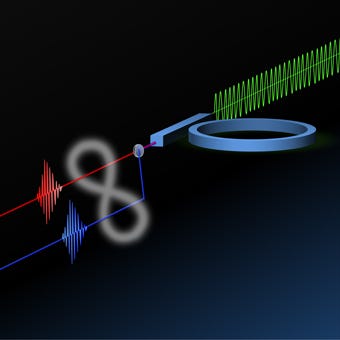Getting Entangled in Quantum Computing
January 28, 2015
|
Drawing of the silicon ring resonator with its access waveguide. Courtesy of Università degli Studi di Pavia, through The Optical Society. |
An international team of researchers has reportedly achieved a significant step toward the development of quantum computing, with the creation of a new micro-ring that can entangle individual particles of light, a breakthrough that could pave the way toward quantum computing capabilities.
The Optical Society reports that the new micro-ring could finally enable researchers to harness the power of entanglement -- the instantaneous connection between two particles, regardless of their distance apart -- onto an ordinary computer chip, making quantum computation possible.
The new design was based on an established silicon technology known as a micro-ring resonator. These resonators can be etched onto silicon wafers, and specifically tailored to create a source of entangled photons that is both incredibly small and highly efficient, making it an ideal chip component.
"The main advantage of our new source is that it is at the same time small, bright, and silicon based," Daniele Bajoni, a researcher at the Università degli Studi di Pavia in Italy and co-author on the paper, told The Optical Society. "The diameter of the ring resonator is a mere 20 mm, which is about one-tenth of the width of a human hair. Previous sources were hundreds of times larger than the one we developed."
It's no secret that quantum computing machines are considered one of the next potentially profound technological breakthroughs that could significantly enhance the world around us. With a machine powered by quantum physics, researchers would be able to execute algorithms, solve problems, and process data at unprecedented speeds, potentially opening the floodgates to advancements in the medtech industry across the board, from diagnostics and medical imaging, to advanced methods of treatment.
While the applications and potential impact of quantum physics remains largely unexplored, researchers continue to inch closer to the idea of machines fueled by quantum physics. Researchers believe quantum computing capabilities could fast track the advancement of many existing technologies. Take magnetic resonance imaging (MRI) for example. Quantum abilities could provide opportunities for enhanced imaging that can detect molecular changes much earlier than existing technologies, as well as enabling early detection of brain chemicals and biomarkers for neurological conditions and cancers.
Many believe these kinds of transformative applications make the study of quantum physics and quantum computation one of the most crucial subjects in modern research. The movement has been so strong it has even moved Google to enter the fray and explore the possibilities.
As for this latest development, the Italian, British, and Canadian researchers believe their work is particularly unique because it demonstrates for the first time, a crucial quantum effect, entanglement, in a well-established technology. Resonators with the ability to generate a continuous supply of entangled photons have been readily created in a lab for some time by large-scale optoelectronic components. The key to creating a machine capable of quantum computations, was downsizing this technology, providing a computer with a cheap, small, and reliable source of entangled photons capable of propagation in fiber networks. It is a key researchers believe they have found in this new micro-ring technology.
As it stands, there are a quite a few cooks in the kitchen, all heavily invested in the research of quantum computing capabilities. Only time will tell whether or not this micro-ring technology will stand to be one of the profound discoveries that will unlock the transformative nature of quantum physics. Regardless of the outcome, the hope is that with this many individuals invested in the research, a groundbreaking discovery will soon be on the horizon.
Refresh your medical device industry knowledge at MD&M West, in Anaheim, CA, February 10-12, 2015. |
Kristopher Sturgis is a contributor to Qmed and MPMN.
Like what you're reading? Subscribe to our daily e-newsletter.
About the Author(s)
You May Also Like



